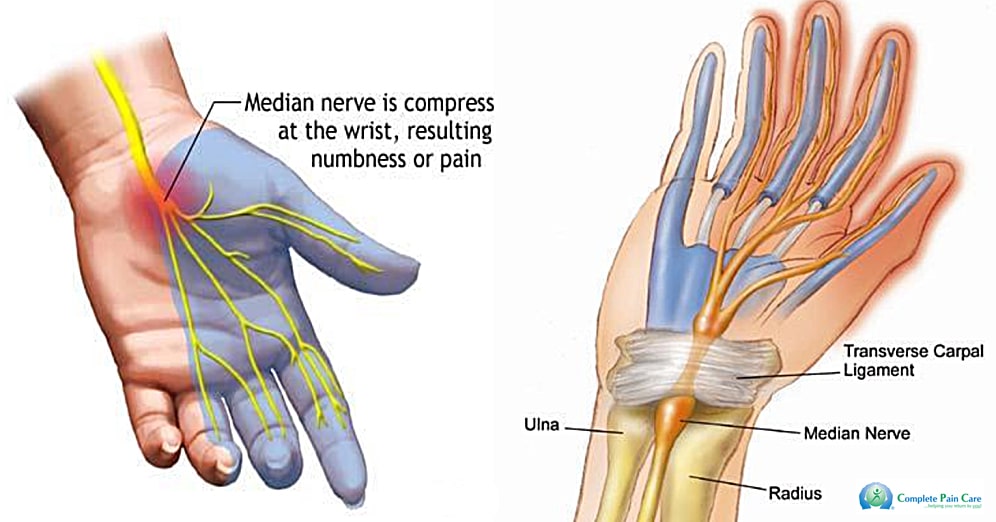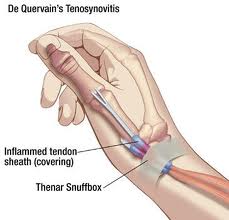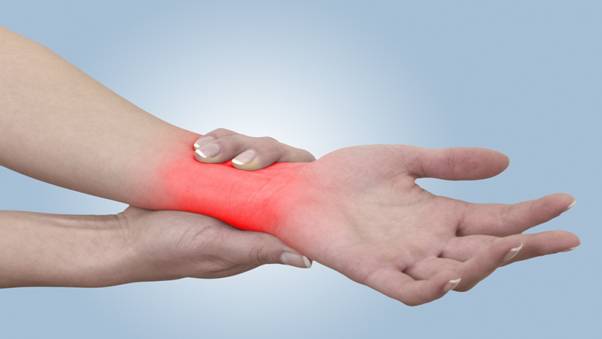Carpal tunnel syndrome and DeQuervain’s tenosynovitis are the most common causes of wrist, hand and finger pain during and after pregnancy.
So you’ve got this cute new human to look after, but your blimmin’ wrists kill you every time you want to pick her up?? Or maybe you’re pregnant with wrist pain, often accompanied with sausage-y swollen fingers and toes?? You are not alone – up to 50% of pregnant women get wrist/hand/finger pain. The most common forms of wrist/hand pain during and after pregnancy are carpal tunnel syndrome and DeQuervain’s tenosynovitis.
Carpal tunnel syndrome

Image credit: https://www.completepaincare.com/patient-education/conditions-treated/carpal-tunnel-syndrome-cts/
The carpal tunnel sits in the middle of the wrist, just below your palm, and is a passage for blood vessels, tendons and nerve.
The hormonal changes during pregnancy cause fluid retention (hence the sausage shaped fingers, cankles and swollen faces of pregnancy) and this can compress the median nerve. The median nerve provides sensation and movement of your fingers and hand.
Symptoms:
- Numbness or tingling of the first three and a half fingers, thumb and hand
- Pain over the fingers, hand or wrist
- Swelling in the fingers, hand and wrist
- Difficulty gripping objects or doing anything dexterous
- Symptoms are usually worse at night due to constant wrist flexion when sleeping
Luckily, carpal tunnel syndrome should subside within a few weeks of giving birth.
Treatment options:
- See a physio for advice on how to avoid aggravating activities (ie how best to pick up or hold your baby, get dressed, open doors, push a pram painfree) and how to strengthen your upper limb
- Posture – Often, poor posture and stiff neck and shoulder movements can further compress the nerve.
- Ice your wrist for 20 mins, 4-5x a day. Alternating between hot and cold water (contrast bathing) may help too.
- Use gravity: whenever you are upright, gravity is pushing fluid down your arms towards your wrists and further exacerbating the problem. Reverse this by sitting with your arms resting above your head, or use pillows to elevate forearms.
- Avoid sleeping on the side of your most affected hand, and prop your top arm and hand on a pillow in front of you.
- Soft tissue massage, wrist mobilization techniques or nerve gliding techniques performed by a physio may help
- A splint may help. You can get one fitted for you (the best option) by a specialized hand physiotherapist or buy one online
- Keep your wrist in a neutral position as much as possible:

Image credit: www.thewomens.org.au
If the above strategies don’t work, you could talk to your doctor about anti-inflammatory medication, cortisone injections or a referral to a specialist for surgery to relieve the pressure.
De Quervain’s Tenosynovitis (mum thumb)

Site of DeQuervain’s tenosynovitis
Coming from someone who has had De Quervain’s (I got mine from waitressing and carrying 15 plates in one hand)… it really does suck. I had a surgical release to treat it, but conservative management can be just as effective if you are diligent. De Quervain’s is an inflammation of the thumb tendon covers on the thumb side of the wrist. These tendons move the thumb and wrist backwards. This inflammation is caused by repetitive movements i.e. lifting a baby (did you know that a new mum lifts her baby between 25-30 times a day on average?), using a mobile phone or playing sports such as golf or tennis.
Symptoms:
- Pain near the base of your thumb
- Pain with gripping, twisting, making a fist or carrying
- Swelling, redness or stiffness of the thumb side of the wrist
Treatment:
- Get a thumb/wrist splint from your physio
- Ice regularly – use an ice cube and rub it over the sore wrist until it is fully melted. Do this 3-4x a day
- Soft tissue massage of the forearm, nerve glides from your physio
- Advice on feeding positions and lifting strategies
- Strengthening of the upper back, arm and hand muscles
If I could give you one piece of advice about DeQuervain’s it would be: seek help ASAP! Waiting too long can make recovery difficult. If you see a physio and do the above strategies and the pain does not subside within 6-8 weeks, you might like to talk to your doctor about medication or injections or surgical release.
– the vagina physio
Image credit: https://www.gachibowliphysiotherapy.com/elbowhandwristpain.html

